The blood parrot cichlid is a hybrid fish and member of the Cichlidae family.
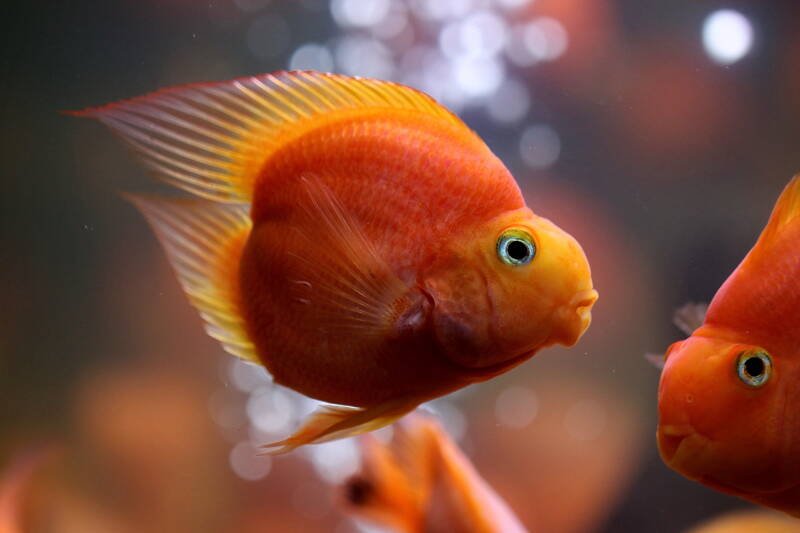
It was created in Taiwan in the mid-1980s through the pairing of two cichlid species.
Although the exact parent species are unknown, they are believed to have been a male Midas cichlid (Amphilophus citrinellus) and a female redhead cichlid (Paraneetroplus synspilus).
There are several variations of this fish, including breeding lines involving the convict or red devil cichlid.
Although they have similar names, be careful to not mistake the blood parrot cichlid, a freshwater fish, with the parrotfish- saltwater species.

At a Glance
| Tank Size: | 30 gallons for a single fish |
| Group Size: | Any |
| Water Temperature: | 76 to 80°F (24 to 26°C) |
| pH: | 6.5 to 7.4 |
| Hardness: | 6 to 18 dGH |
| Lifespan: | 10 to 15 years |
| Breeding: | Egg layer, males typically infertile |
| Adult Size: | 6 to 8 inches |
| Usual Place in the Tank: | Middle to bottom |
In this article
Natural Habitat
As a hybrid fish, the blood parrot cichlid does not really have a “natural habitat” for us to examine.
Because it is a mix of two Central American species, we look to the habitat parameters of the parent fish. These fish come from freshwater streams and rivers with sandy and rocky bottoms.
The rivers are rich with vegetation, submerged roots, and rocky shelters. The water is slightly acidic with a moderate current.
Appearance and Biology
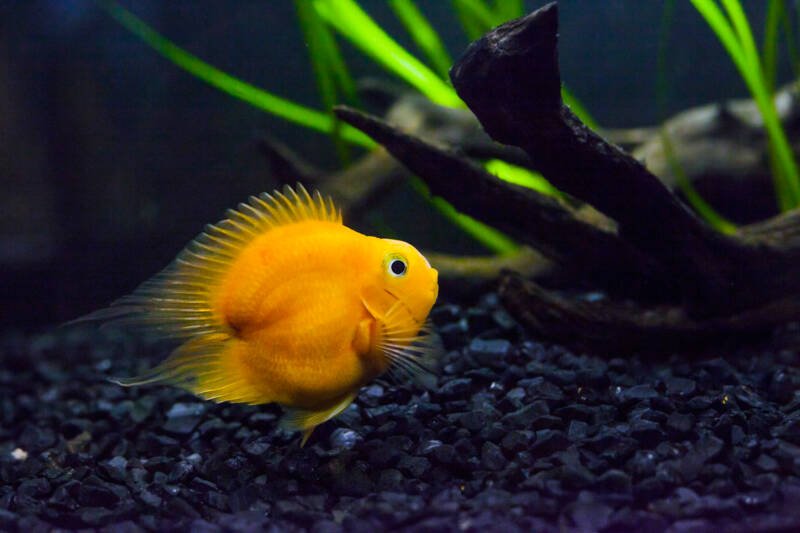
Blood parrot cichlids have a rounded body shape, smaller head, and a large nuchal hump.
Their round head has bright, large eyes. Their fins are large and sweep backward toward a blunt, rounded tail.
Due to hybrid breeding, you may find genetic deformities in some of these fish, such as an overarched spine.

The most notable deformity in the blood parrot cichlid is the fish’s mouth, which cannot completely close. They eat by crushing food with the help of teeth set in their throat.
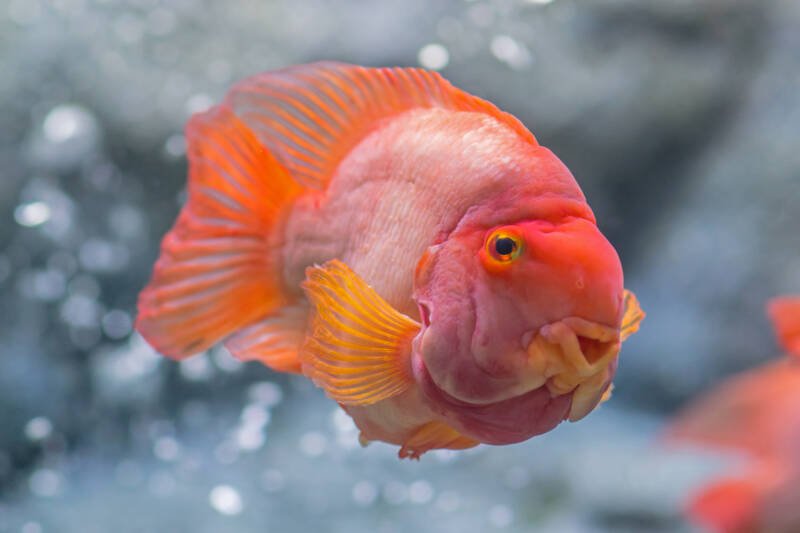
Coloration
When they are young, blood parrot cichlids can be darkly colored with stripes. Within four months, they will change to their adult coloration.
Body color can range from a solid orange to combinations of red/yellow/white or even grey.
Note that occasionally, dyes are injected into the fish to give brighter or more unique colors. Avoid purchasing these fish as the dye significantly shortens their lifespan.
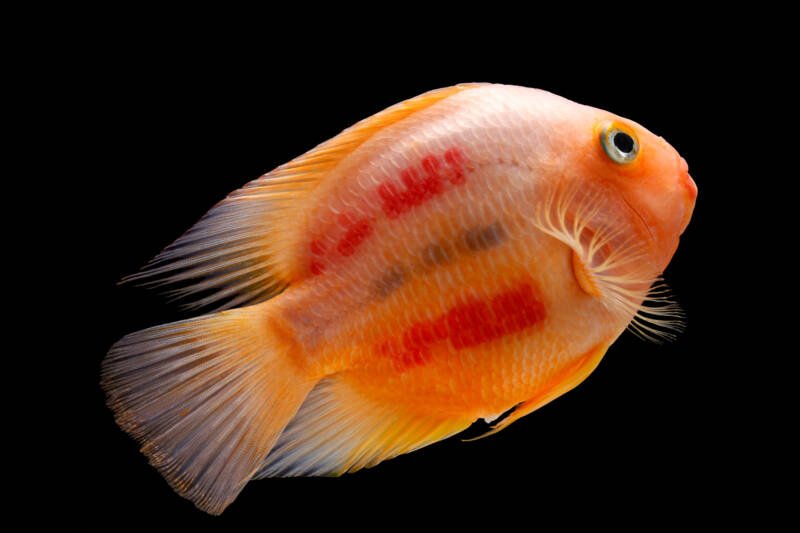
Gender Differences
Male and female blood parrot cichlids look very much alike, and it is difficult to differentiate between the two.
Males may be slightly larger in adulthood, and females may have a more rounded body.
Size
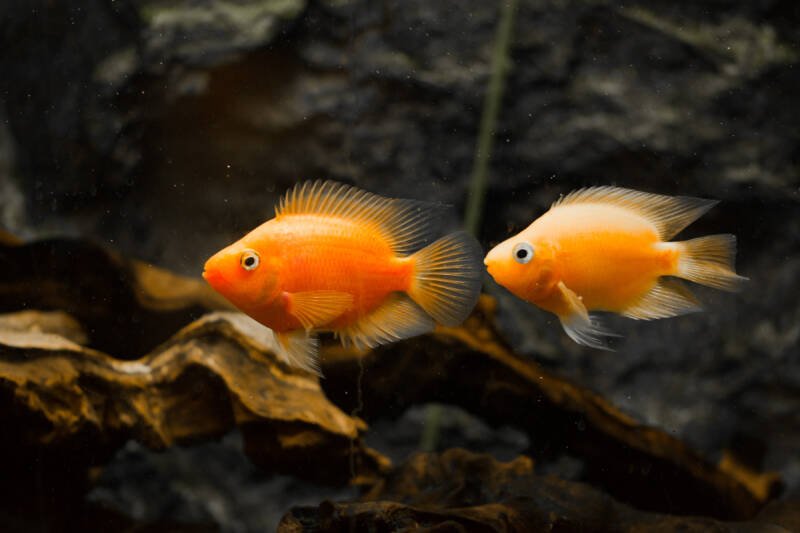
This is a good-sized fish, averaging seven to eight inches in length for males and six to seven inches for females.
In some cases, these fish have even reached up to 10 inches in length.
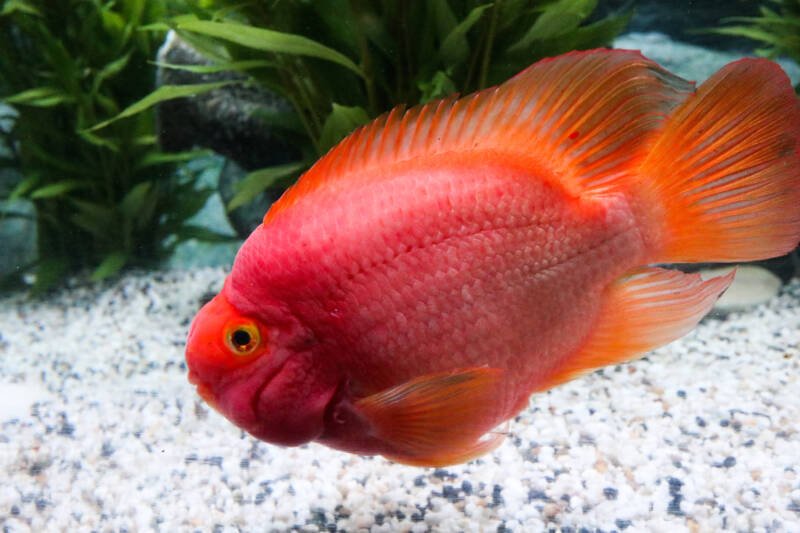
Lifespan
If you invest in a blood parrot cichlid, keep in mind that this fish has a long lifespan.
With proper care, this species can live anywhere from 10 to 15 years. Poor breeding practices and dye injection can impact their lifespan.
Behavior
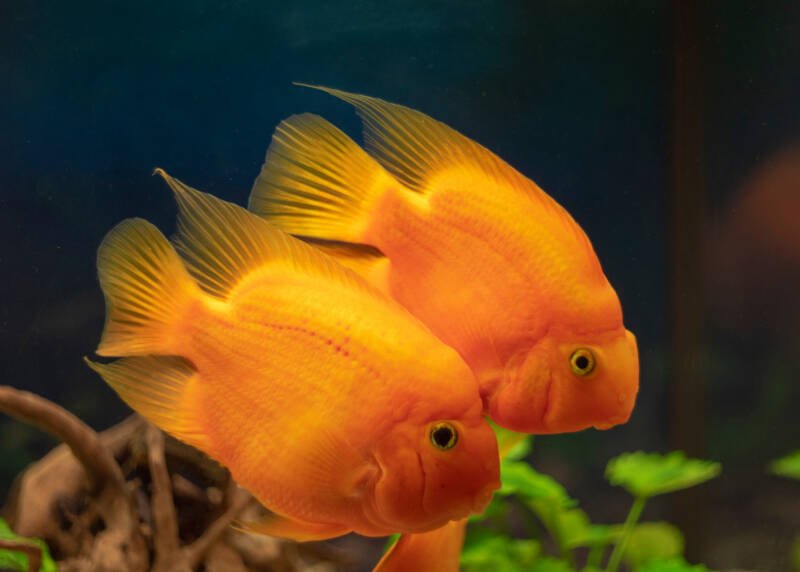
Blood parrot cichlids’ behavior is best when they are in the right environment. They are curious, a bit shy, and playful in a tank where they feel comfortable.
This means providing plenty of space to avoid territorial behavior, plenty of hiding spaces to let them feel secure, and pairing them with peaceful, non-aggressive species.
For the most part, the blood parrot cichlid will hang out near its preferred shelter, swimming in and out of it.

The rest of the time, you will see them swimming in the middle of the water column.Every now and then, they will venture to the bottom and dig.
One behavior you may find endearing is the cichlid’s ability to recognize its owner and swim to greet them.
How many per gallon?
These are large fish, so plan on a minimum tank size of 30 gallons for one blood parrot cichlid.This size allows room for swimming as well as decorations and plants that will provide shelter.
If you want more blood parrot cichlids, add 10 gallons for each additional fish.
Remember that this is a minimum size guide. These fish love swimming space, so if you can go bigger, even better.
Tank Setup
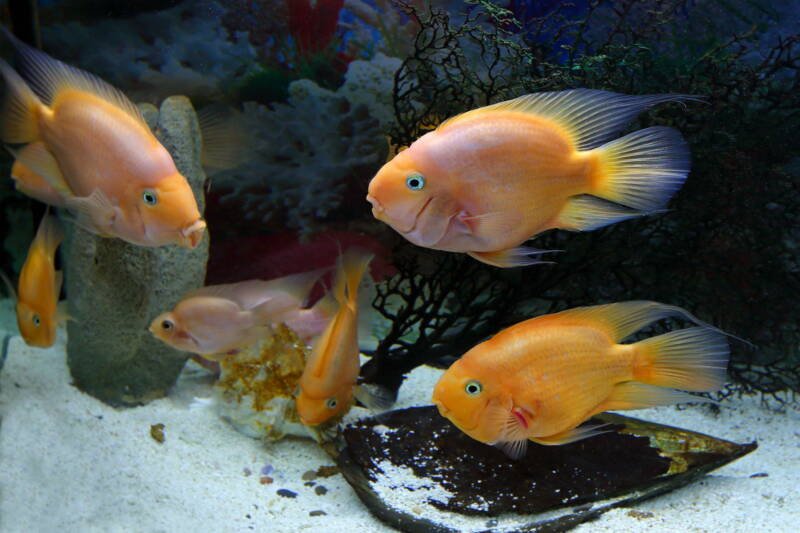
Once you have determined the right volume for your tank, setting it up to make your cichlids happy is simple.
One of the most important things is to have a set open space for swimming and balance that with plenty of hiding places. The need for both open and hiding spaces is the main reason why we recommend going for a larger tank.
Decorations
Start with a soft, sandy substrate. You can make hiding spaces using pots, caves, rocks, driftwood, or plants.

If you go with live plants, some favorites are hornwort, java fern, or anubias.
Remember, however, that these fish are known to dig occasionally, so keep that in mind.This fish does well with both artificial and natural décor.
Water Conditions
The water in your tank should be warm and slightly acidic. Keep the temperature between 76- and 80-degrees Fahrenheit (24 to 26 C). These fish do not require any seasonal temperature changes as they are a hybrid.
The pH range should stay between 6.5 and 7.4 and the hardness from 6 to 18 dGH.
Water conditions are something you will need to keep on top of with blood parrot cichlids as they produce a good amount of waste. Change out 50 percent of the water every two weeks and test the water parameters regularly.
Equipment
To help maintain good water conditions, invest in a quality filtration system that will allow for a moderate current.
Also, because this fish prefers warm water, installing a heater will help ensure a constant temperature. Keep the lighting soft.
Tank Mates
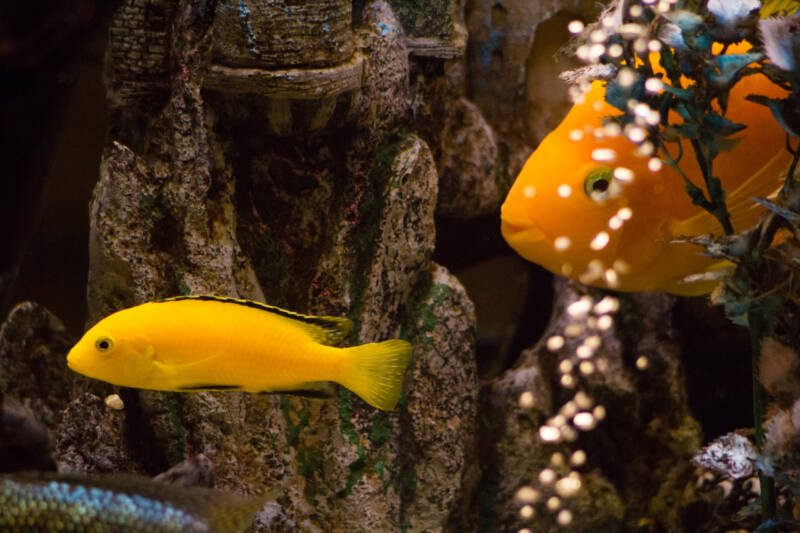
As long as you have the proper tank size and setup, the blood parrot cichlid is a peaceful, easygoing fish.
They enjoy being in a group of their own kind but can also be paired with other similarly sized, peaceful fish in a community tank.
Consider the following to pair with your blood parrot cichlid:
- Other cichlids (firemouth or kribensis)
- Gouramis (dwarf or honey)
- Emperor tetras
- Tiger barbs
- Loaches, catfish, or plecos.
Avoid the following:
- Small shrimps
- Small snails
- Small fish that your cichlid may consider as food, such as guppies, some tetras, rasboras.
Food and Diet
Blood parrot cichlids are omnivores and will eat a variety of foods. Start with a high-quality sinking cichlid pellet.
Feed twice daily and only as much as they can finish in a few minutes. These fish are naturally messy eaters, so remove uneaten food to maintain water quality.
Supplement with high-protein foods two to three times a week. Some favorites are bloodworms, daphnia, or brine shrimp. These can be frozen or live.
Breeding
Breeding your blood parrot cichlid is very difficult. While your female may lay eggs, typically on a flat surface in the tank, the male is usually infertile.
In this case, the eggs will either be eaten by the parents or develop a fungus. Females show more success in spawning when paired with another cichlid species, such as the convict or Midas cichlid.
If you do attempt to breed your blood parrot cichlid, try raising the water temperature to around 80 degrees Fahrenheit and feed the pair a high-protein diet.
If spawning is successful, the parents will care for and protect the eggs. You may observe the parents eating any infertile or fungus-infected eggs.
Should the fry hatch, feed them baby brine shrimp and make sure to change out at least 25% of the water regularly.
Hardiness and diseases
If you are looking for a hardy fish, the blood parrot cichlid is a good choice.A fish coming from a reputable breeder can thrive given a proper diet and well-maintained tank conditions.
Like any freshwater fish, they are susceptible to common tank diseases. Two you may see are ich and swim bladder disease.
Ich
Ich is a parasitic infection that presents as white spots on your fish’s body. It is fatal if left untreated, so isolate any infected fish and treat with over-the-counter medication.
Swim Bladder Disease
Swim bladder disease causes your fish to lose the ability to control their position in the water column.
There are many things that can cause issues with the swim bladder, ranging from infection to water conditions to overeating.
You may even find that some blood parrot cichlids are born with a partially deformed bladder due to breeding practices.
To treat swim bladder disease, do not feed your fish for three days and raise the water temperature between 78- and 80-degrees Fahrenheit during this time. Afterward, feed your fish a cooked, skinned pea every day for the next few days. Then, switch back to normal feeding.
Make sure you are feeding your fish a proper diet, are not overfeeding them, and maintain the water conditions in your tank. These are the best steps to prevent common tank ailments
Frequently Asked Questions

1. Are blood parrot cichlid aggressive?
This fish is not typically aggressive. Any aggression usually comes from not having enough territory, being paired with aggressive species, or not having adequate hiding spaces.
2. Why are my parrot fish kissing?
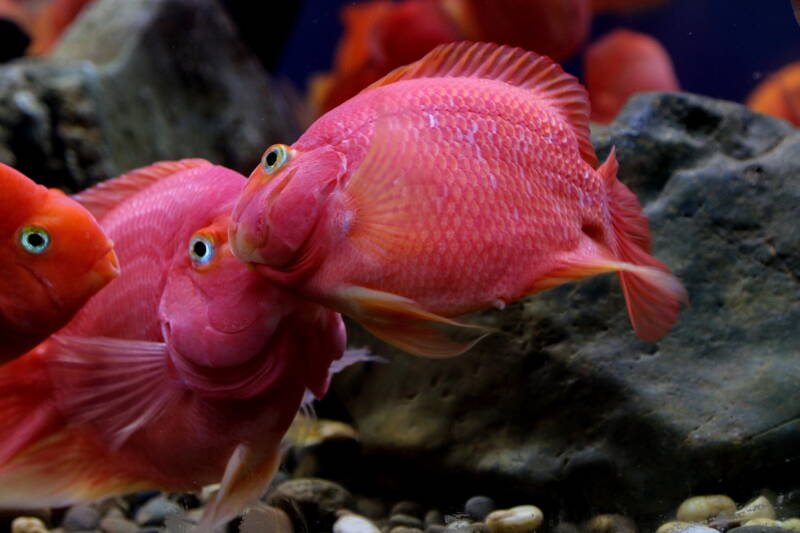
If you see your blood parrot cichlids kissing, this is typically a territorial dispute or an attempt to establish hierarchical dominance.In general, the fish will push back and forth, with one eventually giving in.
Make sure you have an adequately sized tank for the number of fish and plenty of hiding spaces for each fish to feel comfortable.
3. How big do blood parrot cichlids get?
Blood parrot cichlids can reach an average length of seven to eight inches for males and six to seven inches for females.
4. Do blood parrot cichlid have teeth?
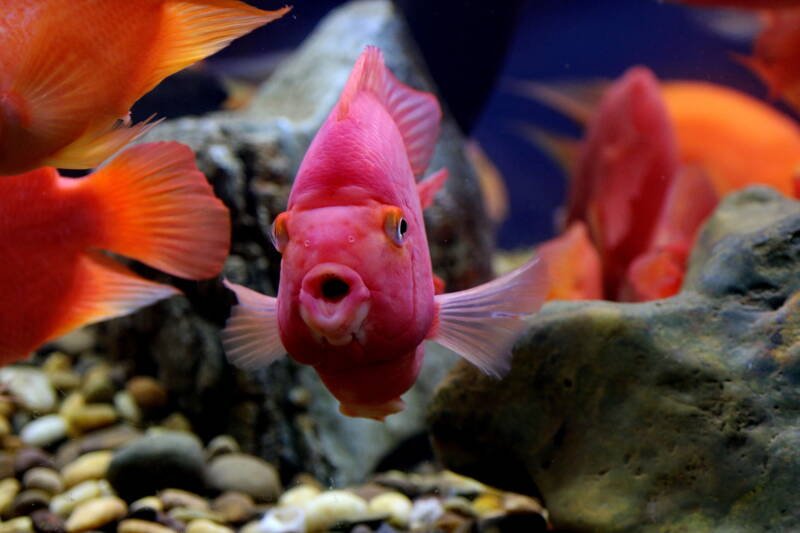
Yes. Due to the common deformation of the mouth, these teeth are located further back in the throat.
5. How often should you feed parrot cichlids?
Feed your fish twice daily and only as much as they can finish in a few minutes.
Remember that they are messy eaters, so clear out any unfinished food to keep your tank conditions optimal.
6. How many blood parrot cichlids can I keep together?
That will depend on the size of your tank. These are fairly large fish, averaging six to eight inches in length, so you will need a minimum tank size of 30 gallons for one blood parrot cichlid. Add 10 gallons for each additional fish.
Final Recommendations
Overall, the blood parrot cichlid is a wonderfully unique fish. They are curious and playful, often recognizing and reacting to their owner.
They get along well in both species-only or community tanks.
Look for a reputable breeder and avoid fish that are dyed, as this reduces their lifespan.
You will find a wide range of prices online – anywhere from $8-9 for a juvenile to close to $30 for an adult.
Remember that there are moderate equipment needs for this fish, such as a larger-sized tank, quality filtration, and a heater. Test kits to maintain water quality should also be on your list.
What are your experiences in keeping blood parrot cichlids?
We would love to hear about your preferred tank setup!